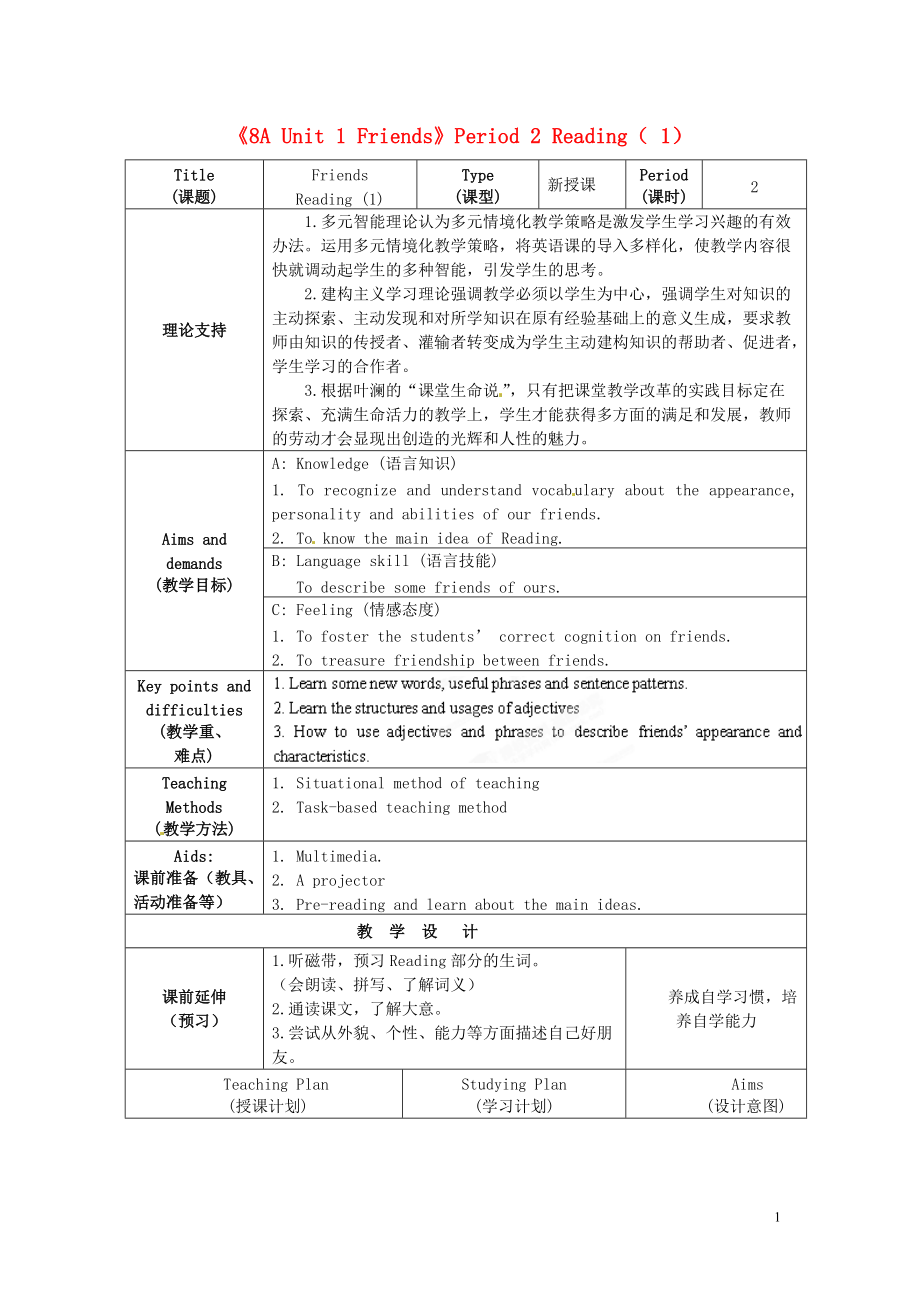《江蘇省海安縣大公初級中學八年級英語上冊《8A Unit 1 Friends》Period 2 Reading(1)教案 牛津版》由會員分享���,可在線閱讀�����,更多相關《江蘇省海安縣大公初級中學八年級英語上冊《8A Unit 1 Friends》Period 2 Reading(1)教案 牛津版(5頁珍藏版)》請在裝配圖網(wǎng)上搜索�����。
1���、
《8A Unit 1 Friends》Period 2 Reading( 1)
Title
(課題)
Friends
Reading (1)
Type
(課型)
新授課
Period
(課時)
2
理論支持
1.多元智能理論認為多元情境化教學策略是激發(fā)學生學習興趣的有效辦法�����。運用多元情境化教學策略����,將英語課的導入多樣化�,使教學內容很快就調動起學生的多種智能,引發(fā)學生的思考���。
2.建構主義學習理論強調教學必須以學生為中心�,強調學生對知識的主動探索���、主動發(fā)現(xiàn)和對所學知識在原有經(jīng)驗基礎上的意義生成�,要求教師由知識的傳授者����、灌輸者轉變成為學生主動建構知識的幫助者、促進者�����,
2�����、學生學習的合作者���。
3.根據(jù)葉瀾的“課堂生命說”�����,只有把課堂教學改革的實踐目標定在探索�����、充滿生命活力的教學上�,學生才能獲得多方面的滿足和發(fā)展����,教師的勞動才會顯現(xiàn)出創(chuàng)造的光輝和人性的魅力�。
Aims and demands
(教學目標)
A: Knowledge (語言知識)
1. To recognize and understand vocabulary about the appearance, personality and abilities of our friends.
2. To know the main idea of Reading.
B: Language
3���、 skill (語言技能)
To describe some friends of ours.
C: Feeling (情感態(tài)度)
1. To foster the students’ correct cognition on friends.
2. To treasure friendship between friends.
Key points and difficulties
(教學重�、
難點)
Teaching Methods
(教學方法)
1. Situational method of teaching
2. Task-based teachi
4�、ng method
Aids:
課前準備(教具、活動準備等)
1. Multimedia.
2. A projector
3. Pre-reading and learn about the main ideas.
教 學 設 計
課前延伸
(預習)
1.聽磁帶�,預習Reading部分的生詞。
(會朗讀����、拼寫、了解詞義)
2.通讀課文���,了解大意����。
3.嘗試從外貌����、個性、能力等方面描述自己好朋友���。
養(yǎng)成自學習慣�,培養(yǎng)自學能力
Teaching Plan
(授課計劃)
Studying Plan
(學習計劃)
Aims
(設計意圖)
5、
課
內
拓
展
學
StepⅠLead-in
1. Listen to an English song. “We are friends”
1.營造學習英語的氛圍���,激起學習興趣。 2.通過歌曲暗示本課所學內容�����,從而導入新課�。
Step II Presentation
(Pre-reading)
Show the photos of Betty, Max
6、and May.
Teach the new words.
Adjectives: slim, generous, willing, ready ,round, smart, bored, shoulder-length, true
Nouns: singer, eyesight, sense, humour, joke, advertisement
Verb: fit
(With the help of the photos.)
2. Explain the context of the reading passage.
(‘Teenagers’ magazine is
7�����、holding a writing competition. It is inviting teenagers to write about their best friends. These are the first three entries for the competition.)
1.通過單詞競賽���,檢查預習單詞情況,為接下來的環(huán)節(jié)做好鋪墊���。(做好過程中激勵性評價)
2.采用相互問答或對話的形式����,在語境中運用生詞,激發(fā)學生興趣�����,對Reading內容有進一步的感性認識����。
導
Step III
Practice
( While-
reading)
Ⅰ. Ski
8、mming
1. Ask students to watch the CD and listen to the passage, pay attention to the pronunciation.
2. Listen to the descriptions and judge who he/she is.
(1) He is very tall, almost 1.75 metres. He has poor eyesight and wears small, round glasses. (Max)
(2) She is small and pretty. She has st
9���、raight, shoulder-length hair. (May)
(3) She is slim and her hair is short. (Betty)
3. Answer the following questions.
(1)Is Betty slim? (Yes, she is.)
(2)What kind of person is she? (She is generous.)
(3)What does she want to do when she grows up?
(To be a singer.)
(4)How tall is Max?
(
10�、Almost 1.75 metres.)
(5)Why does he have poor eyesight? (Because he works on the computer too much at night.)
(6)What kind of person is he? (He has a good sense of humour.)
(7)Is May pretty? (Yes, she is.)
(8)Why is she a true friend? (Because she can keep a secret.)
1. 通過對學生的聽讀訓練����,培養(yǎng)其搜索
11、有用信息的能力�。
2. 強化聽說訓練,提高學生對文章細節(jié)的理解和推斷能力����。
(繼續(xù)做好過程性評價)
II.Scanning
1. Watch the CD again and judge the following statements. Write a T if it is true, write an F if it is false.
(1)Betty is generous to old people only. (F)
(2)Betty wants to be a singer and travel around the world. (T)
(3)Max
12、does a lot of computer work. (T)
(4)Max is very good at telling jokes. (T)
(5)May is a true friend. (T)
(6).May likes to tell others her friends’ secrets. (F)
2. Read the passage together and fill in the blanks.
(1) May is a true friend —she can keep a secret.
(2) Max looks smart and has a go
13���、od sense of humour.
(3) Betty is generous and helpful— she is always willing to share things and help others.
3. Check the answers.
4. Read together.
實施因材施教�,尊重學生的個性差異,分層要求�����。在學生自學過程中����,教師通過觀察�����、詢問���,有計劃地點撥學困生���,鼓勵其大膽質疑;有針對性地向優(yōu)生提出深層次的問題���,使他們的聰明才智得到充分發(fā)揮����。
練
Step IV
Production
(Post-reading)
14����、
Vote for the best friend
I. Amy, Simon and Sandy want to vote for the best friend. Who will they vote for? What are they saying? Fill in the blanks to complete the sentences.
Amy: I’ll vote for ____ because my best friend shouldn’t tell others my secrets.
Simon: I’ll vote for _____ because I
15���、like funny people. They can make me happy when I’m sad.
Sandy: I’ll vote for ____ because my best friend should share things with me and help people in need.
II. In your class, who will you vote for the best friend?
讓學生在小組內討論,培養(yǎng)學生的口語表達能力����。(教師巡視、了解�,點撥有困難的學生大膽開口,引導優(yōu)生發(fā)揮才智�����。充分體現(xiàn)面向全體學生�����,注重他們整體素質的提高���。)
課后提升
Step V Assignment
1. Recite all the new words.
2. Write an article about your best friend.
控制作業(yè)量���,既落實雙基,又重視知識面的拓寬和能力的提升�����。(關心學生的認知發(fā)展)
5
 江蘇省海安縣大公初級中學八年級英語上冊《8A Unit 1 Friends》Period 2 Reading(1)教案 牛津版
江蘇省海安縣大公初級中學八年級英語上冊《8A Unit 1 Friends》Period 2 Reading(1)教案 牛津版

